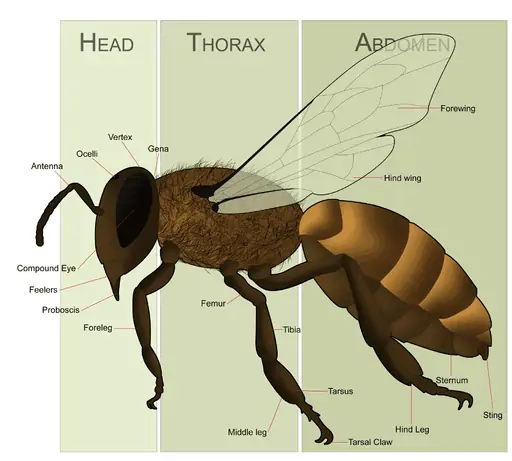When you consider all the many reasons that honeybees are such awesome creatures, their specially designed anatomy is certainly one of the most amazing. Every honeybee has a body whose features are specific to their role within the colony, with an anatomy and lifespan that differ slightly depending on whether they were born as a queen, drone, or worker bee.
No matter their role, every honeybee’s exoskeleton is covered in tiny hairs and is divided into 3 sections.
The Head
Honeybees have multiple sets of eyes, compound and simple, allowing them to see the world in polarized light. Their head is also home to a set of mandibles, or strong jaws, that keep their mouthparts safe, like their proboscis used to reach nectar far inside of flowers (this is similar to a tongue, but not quite the same). Atop their head, bees have two sets of segmented antennae, just as integral to their senses as their tiny, yet quite complex & still impressive brains.
The Thorax
The mid-section of a bee’s body, or its thorax, is primarily used to keep the bee moving, serving as a base for its 6 legs and 2 pairs of wings to attach to the bee. Thorax muscles allow bees to do many things, like rapidly move their wings in flight, or when flapping wings to “fan” the hive and remove excess moisture, as well as emit the vibrations we know as buzzing. Each of their 2 legs is split into six segments, giving them the flexibility to help with many tasks, especially for worker bees, who have special hairs that form a “basket” of sorts, used to pack and carry pollen and propolis back to the hive.
The Abdomen
Potentially the most important part of any honeybee, the abdomen houses many essential organs, such as those necessary for honeybee reproduction. The glands needed to create wax and build comb are located on the underside of a worker’s abdomen. The ever-important stinger, used for defense against threats, is also attached to the end of the abdomen, but drones don’t need to have one of those, only a queen or worker bee does! Equally as important to a honeybee’s life, the honey stomach, or honey crop, is also located on the abdomen and is used to store collected nectar until they return to the hive.

A honeybee’s anatomy is even MORE amazing when you consider the way that they’ve adapted and changed their bodies to do things like better mitigate threats, forage for resources, and communicate amongst themselves. They can even change their entire chemical makeup with the development of winter bees, whose bodies are specifically designed to survive cold and harsh winters. Each honeybee’s adaptability and specialized features make them an essential part of not just their colonies but the entire ecosystem around them.
Read More
How Bees Sense & React to Their World
A Deeper Look at Honeybee Anatomy *
The Common Races of Honeybees *
* Colony Member-Only Content
